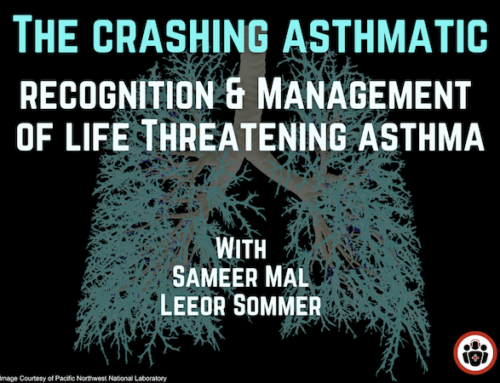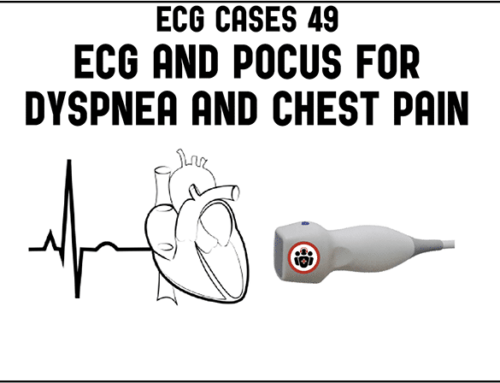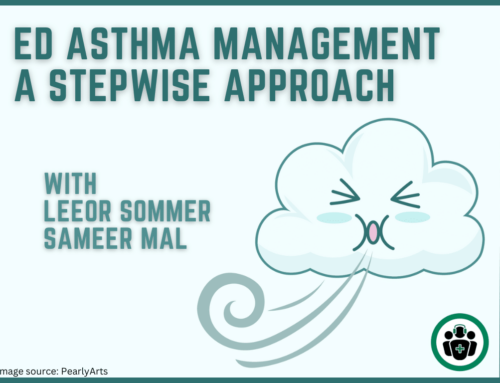We work up a lot of patients for pulmonary embolism. Most of them are not very sick. Dr. Salim Rezaie of R.E.B.E.L. EM tells his Best Case Ever of a Low Risk Pulmonary Embolism that begs us to consider a work-up and management plan that we might not otherwise consider. With new CHEST guidelines suggesting that subsegmental pulmonary embolism need not be treated with anticoagulants in every patient, exceptions to the Well’s Score and PERC rule to help guide work-ups, the adaptation of outpatient management of pulmonary embolism, and the option of NOACs rather than warfarin for treatment, the management of pulmonary embolism in 2016 has evolved considerably. In which situations would you treat subsegmental pulmonary embolism? How comfortable are you sending patients home with pulmonary embolism? How does the patient’s values play into these decisions? Listen to Dr. Rezaie provide an insightlful perspective on these important issues and much more…
Recorded November 2015 and Februrary 2016; Published February 2016 by Anton Helman & Salim Rezaie
This podcast release marks the 5 year anniversary
of The Best Case Ever podcast series!
Which patients with low risk pulmonary embolism do not require anticoagulation?
Soon after we recorded this Best Case Ever, the American College of Chest Physicians came out with their updated guidelines for the treatment of venous thromboembolism disease. One of the key recommendations has to do with the treatment of new isolated subsegmental pulmonary embolism. “In patients with subsegmental PE and no proximal DVT in the legs who have a low risk for recurrent venous thromboembolism, we suggest clinical surveillance over antigoaculation, and those who have a high risk for recurrent venous thromboembolism, we suggest anticoagulation.”
So whether you treat or not depends on whether the patient is high or low risk for recurrent or progressive PE. Which patients are considered high risk you may ask?
Patients who are:
- hospitalized or have reduced mobility for another reason
- have active cancer
- have no reversible risk factor for VTE such as recent surgery
They also suggest that patients with low cardiopulmonary reserve or marked symptoms that cannot be attributed to another diagnosis should get anticoagulated.
Their explanation for this recommendation is that true subsegmental PE is likely to come from a small DVT (and so the risk of progressive or recurrent PE is low), and that many of these so-called subsegmental PEs are false positive over-calls by the radiologist.
They do admit the the evidence for their recommendations are not based on high quality RCTs, but I think the take home message is that we don’t have to anticoagulate every patient with a PE.
Criteria for outpatient treatment of low risk pulmonary embolism
The following are two different sets of criteria to consider for outpatient management of patients with low risk pulmonary embolism.
Criteria for outpatient treatment of low risk pulmonary embolism: The Simplified PESI Score
The absence of all of the following:
Age > 80 years
History of Cancer
History of chronic cardiopulmonary disease
Heart rate >110
Systolic BP <100
O2 Saturation <90%
Exclusion criteria: patients with renal failure or severe comorbidities
A score of 0 portends a 30 day mortality risk of 1.1%.
Outpatient management saved $4,500 USD per avoided admission in one study.
Update 2023: A post-hoc analysis of the YEARS study including 352 patients found that the National Early Warning Score (NEWS) at a threshold of 3 points had a sensitivity and specificity of 92% and 53% for ICU admission, and 100% and 52% for 30-day mortality, which was comparable to a PESI threshold of 66 points (sensitivity of 75% and specificity of 38% for ICU admission, and sensitivity of 100% and specificity of 37% for mortality). Abstract
Criteria for outpatient treatment of low risk pulmonary embolism: Modified Hestia Criteria
The absence of all of the following:
Systolic hypotension
Contraindication to low-molecular-weight heparin or warfarin treatment (active bleeding or high-risk postoperative status, creatinine clearance
Other medical condition requiring hospital treatment (sepsis, new or decompensated existing organ failure, intractable pain)
Social condition requiring hospital treatment (homelessness with history of nonadherence to treatment, suspected neglect or abuse, untreated psychosis, severe alcohol or drug dependency)
Coagulopathy, any INR > 1.7, or thrombocytopenia (platelet count < 50 x 109/L)
Pregnancy
Incarceration
Dr. Helman and Dr. Rezaie have no conflicts of interest to declare
For the EM Cases main episode on pulmonary embolism with Anil Chopra and John Foote go here
References
Kearon C, Akl EA, Ornelas J, et al. Antithrombotic Therapy for VTE Disease: CHEST Guideline and Expert Panel Report. Chest. 2016;149(2):315-52. Full PDF
Jiménez D, Aujesky D, Moores L, et al. Simplification of the pulmonary embolism severity index for prognostication in patients with acute symptomatic pulmonary embolism. Arch Intern Med. 2010;170(15):1383-9.
Vinson DR, Zehtabchi S, Yealy DM. Can selected patients with newly diagnosed pulmonary embolism be safely treated without hospitalization? A systematic review. Ann Emerg Med. 2012;60(5):651-662.e4.
Beam DM et al. Immediate Discharge and Home Treatment with Rivaroxaban of Low-risk Venous Thromboembolism Diagnosed in Two U.S. emergency Departments: A One-year Preplanned Analysis. Acad Emerg Med 2015; 22(7): 788-95. Abstract
More FOAMed Resources on Outpatient Management of Low Risk Pulmonary Embolism
Paul Hernandez and Mark Silverberg review the evidence for outpatient management of PE on emDocs
Ken Milne and Chris Carpenter’s critical appraisal of the 2012 Annals of EM systematic review of outpatient managment of PE on The SGEM
Simplified PESI score calculation on MDCalc
Salim Rezaie and Anand Swaminathan tackle outpatient management of pulmonary embolism on RebelCast





[…] Anton Helman at EM Cases: Best Case Ever 44 – Low Risk Pulmonary Embolism […]
One of the recommendations in the CHEST guidelines is to treat patients with active cancer and subsegmental PEs with anticoagulants. If the patient does not have a known cancer history or the cancer isn’t discovered in the same visit, then surveillance can be considered.
What if this is rare case that a sub-segmental pulmonary embolus is the first presentation of someone with active cancer.
I’m not sure the pts multiple bilat subsegmental PEs w/ evidence of pulmonary infarction fit the CHEST statement regarding ‘isolated’ subsegmental PE recommendations. Seems like a very different pt population.
Before the 2016 CHEST recommendations, were there any guidelines that specifically spoke about the management of subsegmentals? Did CHEST have a previous stance on it? Thanks!
Before 2015 I don’t think there were any guidelines that recommended no anticoags for subsegmentals.